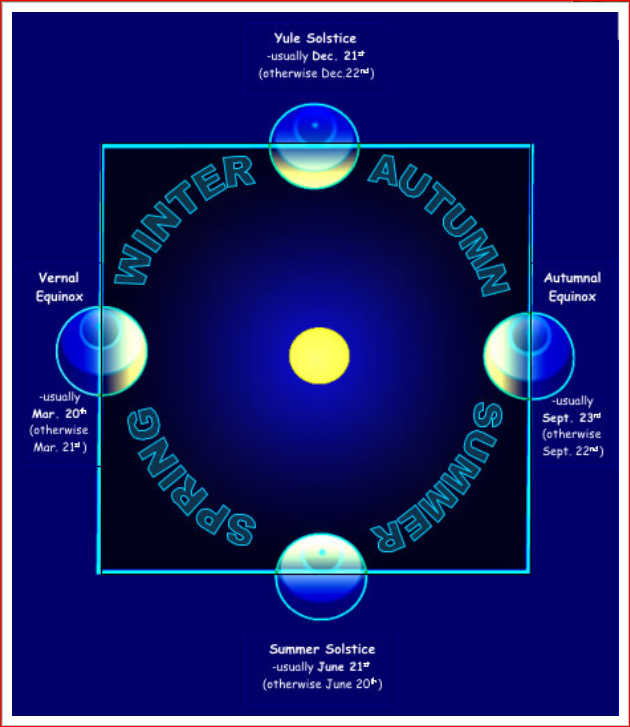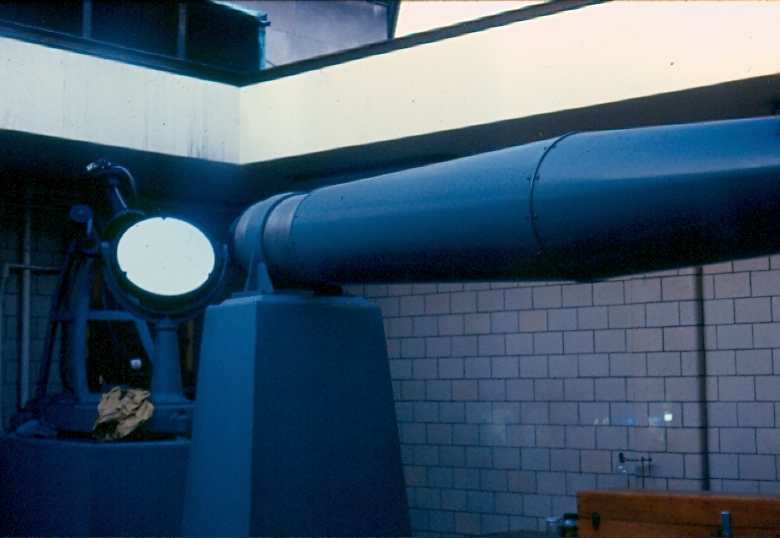
This diagram shows the position of the Earth, in relation to the Sun, at the time of the Autumnal Equinox, as well as the other solstices and equinox of the year.
(Graphic Source: ©1999, Eric G. Canali, former Floor Manager of Pittsburgh's original Buhl Planetarium and Institute of Popular Science and Founder of the South Hills Backyard Astronomers amateur astronomy club; permission granted for only non-profit use with credit to author.)
By Glenn A. Walsh
Reporting for SpaceWatchtower
The Autumnal Equinox, the beginning of
the season of Autumn or Fall in the Northern Hemisphere of Earth,
begins Thursday Morning, 2016 September 22 at 10:21 a.m.
Eastern Daylight Saving Time (EDT) / 14:21 Coordinated Universal Time
(UTC) (the time of the posting of this blog-post).
In Earth's Southern Hemisphere, this
marks the astronomical beginning of the season of Spring.
On the day of Equinox, the Sun appears directly overhead at local Noon on the Equator. At the moment of Equinox, the Northern and Southern Hemispheres of Earth are illuminated equally. And, the time of Equinox is the only time when the terminator (dividing line on Earth between daylight and darkness) is perpendicular to the Equator.
This, and the reason for seasons on Earth in the first place, is due to the fact that Earth rotates on its axis, which is tilted at an approximate 23.44-degree angle from the plane of the Earth's orbit around the Sun. As the Earth revolves around the Sun, this axial tilt causes one hemisphere of the planet to receive more direct solar radiation during that hemisphere's season of Summer and much less direct solar radiation a half-year later during that hemisphere's season of Winter. As mentioned, during an Equinox (about half-way between Summer and Winter, and about half-way between Winter and Summer) both planetary hemispheres receive an equal amount of solar radiation.
On the day of Equinox, the Sun appears directly overhead at local Noon on the Equator. At the moment of Equinox, the Northern and Southern Hemispheres of Earth are illuminated equally. And, the time of Equinox is the only time when the terminator (dividing line on Earth between daylight and darkness) is perpendicular to the Equator.
This, and the reason for seasons on Earth in the first place, is due to the fact that Earth rotates on its axis, which is tilted at an approximate 23.44-degree angle from the plane of the Earth's orbit around the Sun. As the Earth revolves around the Sun, this axial tilt causes one hemisphere of the planet to receive more direct solar radiation during that hemisphere's season of Summer and much less direct solar radiation a half-year later during that hemisphere's season of Winter. As mentioned, during an Equinox (about half-way between Summer and Winter, and about half-way between Winter and Summer) both planetary hemispheres receive an equal amount of solar radiation.
Although "Equinox" in Latin means equal-night, the day of the Equinox does not actually have an equal amount of daylight and nightfall, as it appears on the Earth's surface. If the Sun was just a pin-point of light in our sky, as all other stars appear, day and night would be equal.
But, because the Sun is a disk, part of the Sun has risen above the horizon before the center of the sun (which would be the pin-point of light); so there are extra moments of light on the Equniox. Likewise, part of the Sun is still visible, after the center of the Sun has set.
Additionally, the refraction of sunlight by our atmosphere causes sunlight to appear above the horizon, before sunrise and after sunset.
September 25 will mark the Equilux ("equal-light"), the actual day with equal hours and minutes of the Sun above the horizon, and equal hours and minutes of the Sun below the horizon. The Equilux occurs twice each year, approximately 3-to-4 days before the Vernal Equinox and 3-to-4 days after the Autumnal Equinox.
An urban legend that has been making the rounds for decades has it that
eggs can be stood on their ends only during an Equinox, whether the
Vernal Equinox in the Spring or the Autumnal Equinox in the Fall. This
is completely false. Depending greatly on the size and shape of the
particular egg, eggs can be stood on their ends any day of the year!
Astronomy has nothing to do with whether an egg can stand on its end. If
an egg can stand on its end on the Equinox (and, due to the shape and
size of some eggs, this is not even possible), it can stand the same way
any other day of the year.
In the last few years, with the help of the Internet and Social Media, another urban legend has become prevalent. Now it is claimed that brooms can stand, on their own, on their bristles, only on an Equinox day. This is also false. Again, as with eggs, if a broom can stand on its bristles by itself (this usually only works with newer brooms, with more even bristles) on an Equinox, it can do so any day of the year!
September 22 is also designated as the annual Falls Prevention Awareness Day for this year.
In the last few years, with the help of the Internet and Social Media, another urban legend has become prevalent. Now it is claimed that brooms can stand, on their own, on their bristles, only on an Equinox day. This is also false. Again, as with eggs, if a broom can stand on its bristles by itself (this usually only works with newer brooms, with more even bristles) on an Equinox, it can do so any day of the year!
September 22 is also designated as the annual Falls Prevention Awareness Day for this year.
Internet Links to Additional Information ---
Autumnal
Equinox: Link >>>
http://scienceworld.wolfram.com/astronomy/AutumnalEquinox.html
Season of Autumn or Fall: Link >>> http://en.wikipedia.org/wiki/Autumn
Equinox: Link >>> http://en.wikipedia.org/wiki/Equinox
Earth's Seasons: Link >>>
http://en.wikipedia.org/wiki/Season
Tilt of a planet's axis: Link >>> http://en.wikipedia.org/wiki/Axial_tilt
Urban legend of eggs and brooms standing on their own, only on an Equinox:
Link >>> http://www.snopes.com/science/equinox.asp
Falls Prevention Awareness Day: Link >>> http://www.ncoa.org/improve-health/center-for-healthy-aging/falls-prevention/falls-prevention-awareness.html
Special Thanks: Eric G. Canali, former Floor Manager of Pittsburgh's original Buhl Planetarium and Institute of Popular Science and Founder of the South Hills Backyard Astronomers amateur astronomy club.
Tilt of a planet's axis: Link >>> http://en.wikipedia.org/wiki/Axial_tilt
Urban legend of eggs and brooms standing on their own, only on an Equinox:
Link >>> http://www.snopes.com/science/equinox.asp
Falls Prevention Awareness Day: Link >>> http://www.ncoa.org/improve-health/center-for-healthy-aging/falls-prevention/falls-prevention-awareness.html
Special Thanks: Eric G. Canali, former Floor Manager of Pittsburgh's original Buhl Planetarium and Institute of Popular Science and Founder of the South Hills Backyard Astronomers amateur astronomy club.
2016 Sept. 22.

2016: 75th Year of Pittsburgh's Buhl Planetarium Observatory
Link >>> http://spacewatchtower.blogspot.com/2016/01/astronomical-calendar-2016-january.html
Like This Post? - Please Share!
Want to receive SpaceWatchtower blog posts in your inbox ?
Send request to < spacewatchtower@planetarium.cc >.
gaw
Glenn A. Walsh, Project Director, Friends of the Zeiss: < http://buhlplanetarium.tripod.com/fotz/ >
& SpaceWatchtower Editor / Author: < http://buhlplanetarium2.tripod.com/weblog/spacewatchtower/gaw/ >
Electronic Mail - < gawalsh@planetarium.cc >
Twitter Feed: < https://twitter.com/spacewatchtower >
SpaceWatchtower Blog: < http://spacewatchtower.blogspot.com/ >
LibraryWatchtower Blog: < http://librarywatchtower.blogspot.com >
South Hills Backyard Astronomers Blog: < http://shbastronomers.blogspot.com/ >
Barnestormin Blog: Writing, Essays, Pgh. News, etc.: < http://www.barnestormin.blogspot.com/ >
Author of History Web Sites on the Internet --
* Buhl Planetarium, Pittsburgh:
< http://www.planetarium.
* Adler Planetarium, Chicago:
< http://adlerplanetarium.
* Astronomer, Educator, Optician John A. Brashear:
< http://johnbrashear.tripod.com >
* Andrew Carnegie & Carnegie Libraries:
< http://www.andrewcarnegie.
* Civil War Museum of Andrew Carnegie Free Library:
< http://garespypost.tripod.com >
* Duquesne Incline cable-car railway, Pittsburgh:
< http://inclinedplane.tripod.
* Public Transit:
< http://andrewcarnegie2.tripod.

2016: 75th Year of Pittsburgh's Buhl Planetarium Observatory
Link >>> http://spacewatchtower.blogspot.com/2016/01/astronomical-calendar-2016-january.html
Like This Post? - Please Share!
Want to receive SpaceWatchtower blog posts in your inbox ?
Send request to < spacewatchtower@planetarium.cc >.
gaw
Glenn A. Walsh, Project Director, Friends of the Zeiss: < http://buhlplanetarium.tripod.com/fotz/ >
& SpaceWatchtower Editor / Author: < http://buhlplanetarium2.tripod.com/weblog/spacewatchtower/gaw/ >
Electronic Mail - < gawalsh@planetarium.cc >
Twitter Feed: < https://twitter.com/spacewatchtower >
SpaceWatchtower Blog: < http://spacewatchtower.blogspot.com/ >
LibraryWatchtower Blog: < http://librarywatchtower.blogspot.com >
South Hills Backyard Astronomers Blog: < http://shbastronomers.blogspot.com/ >
Barnestormin Blog: Writing, Essays, Pgh. News, etc.: < http://www.barnestormin.blogspot.com/ >
Author of History Web Sites on the Internet --
* Buhl Planetarium, Pittsburgh:
< http://www.planetarium.
* Adler Planetarium, Chicago:
< http://adlerplanetarium.
* Astronomer, Educator, Optician John A. Brashear:
< http://johnbrashear.tripod.com >
* Andrew Carnegie & Carnegie Libraries:
< http://www.andrewcarnegie.
* Civil War Museum of Andrew Carnegie Free Library:
< http://garespypost.tripod.com >
* Duquesne Incline cable-car railway, Pittsburgh:
< http://inclinedplane.tripod.
* Public Transit:
< http://andrewcarnegie2.tripod.
No comments:
Post a Comment